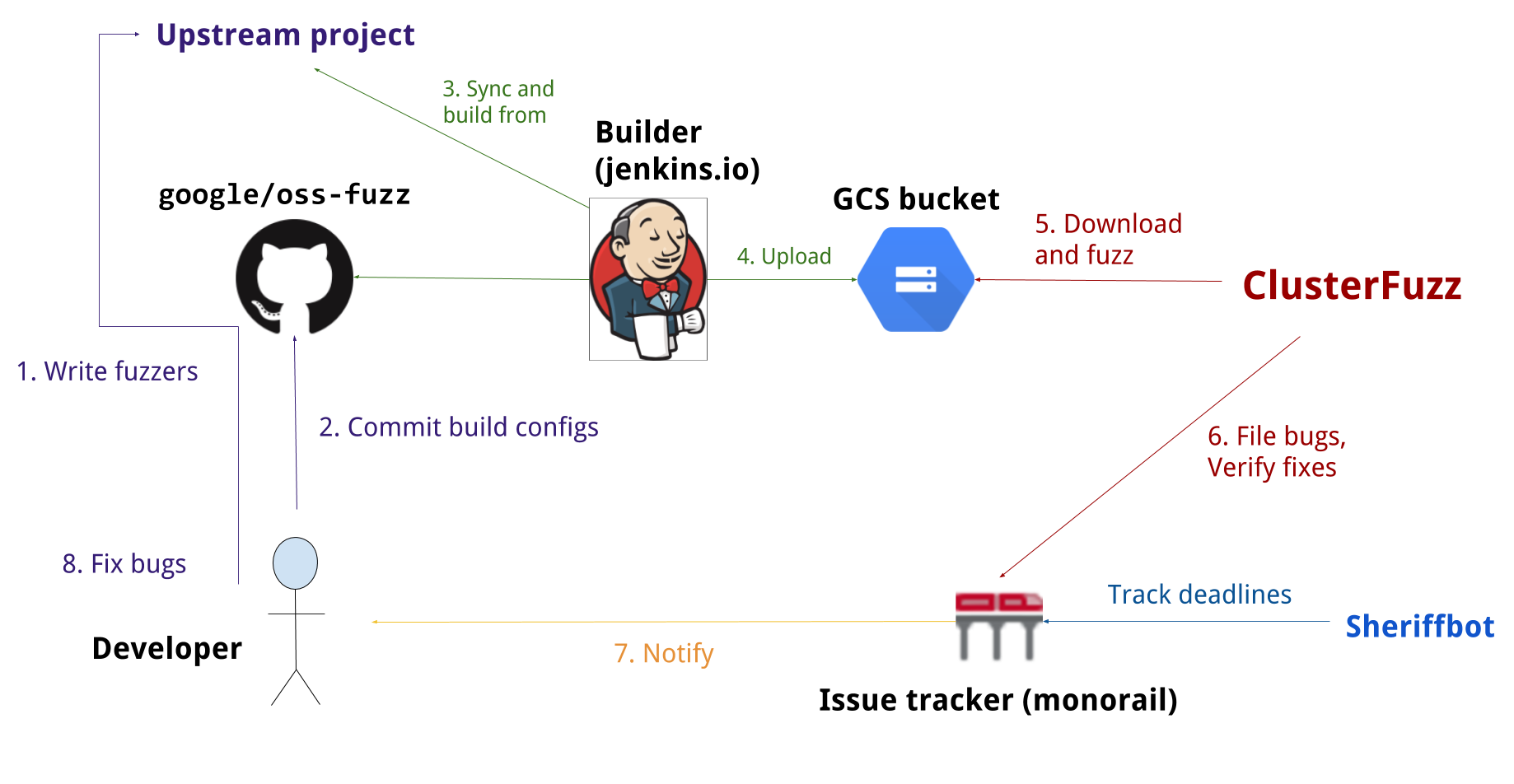|
|
||
|---|---|---|
| docs | ||
| infra | ||
| projects | ||
| .gitignore | ||
| .travis.yml | ||
| CONTRIBUTING | ||
| LICENSE | ||
| README.md | ||
README.md
OSS-Fuzz - Continuous Fuzzing for Open Source Software
Status: Stable. We are accepting applications from widely-used open source projects.
FAQ | Integration Rewards | New Project Guide | Ideal Fuzzing Integration | Reproducing Bugs | Current Projects | Projects Issue Tracker | Glossary
Create New Issue for questions or feedback about OSS-Fuzz.
Introduction
Fuzz testing is a well-known technique for uncovering various kinds of programming errors in software. Many of these detectable errors (e.g. buffer overflow) can have serious security implications.
We successfully deployed guided in-process fuzzing of Chrome components and found hundreds of security vulnerabilities and stability bugs. We now want to share the experience and the service with the open source community.
In cooperation with the Core Infrastructure Initiative, OSS-Fuzz aims to make common open source software more secure and stable by combining modern fuzzing techniques and scalable distributed execution.
We support libFuzzer and AFL as fuzzing engines in combination with Sanitizers. ClusterFuzz provides a distributed fuzzer execution environment and reporting. You can checkout ClusterFuzz here.
Currently OSS-Fuzz supports C and C++ code (other languages supported by LLVM may work too).
Process Overview
The following process is used for projects in OSS-Fuzz:
- A maintainer of an opensource project or an outside volunteer creates one or more fuzz targets and integrates them with the project's build and test system.
- The project is accepted to OSS-Fuzz.
- When ClusterFuzz finds a bug, an issue is automatically reported in the OSS-Fuzz issue tracker (example). (Why use a different tracker?). Project owners are CC-ed to the bug report.
- The project developer fixes the bug upstream and credits OSS-Fuzz for the discovery (commit message should contain the string 'Credit to OSS-Fuzz').
- ClusterFuzz automatically verifies the fix, adds a comment and closes the issue (example).
- 30 days after the fix is verified or 90 days after reporting (whichever is earlier), the issue becomes public (guidelines).
Accepting New Projects
To be accepted to OSS-Fuzz, an open-source project must have a significant user base and/or be critical to the global IT infrastructure. To submit a new project:
- Create a pull request with new
projects/<project_name>/project.yamlfile (example) giving at least the following information:- project homepage.
- e-mail of the engineering contact person to be CCed on new issues. It should:
- belong to an established project committer (according to VCS logs). If this is not you or the email address differs from VCS, an informal e-mail verification will be required.
- be associated with a Google account (why?). If you use an alternate email address linked to a Google Account, it will ONLY give you access to filed bugs in issue tracker and NOT to ClusterFuzz dashboard (due to appengine api limitations).
- Note that
project_namecan only contain alphanumeric characters, underscores(_) or dashes(-).
- Once accepted by an OSS-Fuzz project member, follow the New Project Guide to configure your project.
Bug Disclosure Guidelines
Following Google's standard disclosure policy OSS-Fuzz will adhere to following disclosure principles:
- Deadline. After notifying project authors, we will open reported issues to the public in 90 days, or 30 days after the fix is released (whichever comes earlier).
- Weekends and holidays. If a deadline is due to expire on a weekend, the deadline will be moved to the next normal work day.
- Grace period. We have a 14-day grace period. If a 90-day deadline expires but the upstream engineers let us know before the deadline that a patch is scheduled for release on a specific day within 14 days following the deadline, the public disclosure will be delayed until the availability of the patch.
More Documentation
- Glossary describes the common terms used in OSS-Fuzz.
- New Project Guide walks through the steps necessary to add new projects to OSS-Fuzz.
- Ideal Integration describes the steps to integrate fuzz targets with your project.
- Accessing corpora describes how to access the corpora we use for fuzzing.
- Fuzzer execution environment documents the environment under which your fuzzers will be run.
- Projects lists OSS projects currently analyzed by OSS-Fuzz.
- Chrome's Efficient Fuzzer Guide while containing some Chrome-specific bits, is an excellent guide to making your fuzzer better.
- Blog posts:
Build Status
This page gives the latest build logs for each project.
(Internal only) Builds dashboard.
Web Interface
- The main page: oss-fuzz.com
- ClusterFuzz for OSS-Fuzz documentation
Trophies
This page gives a list of publicly-viewable fixed bugs found by OSS-Fuzz.
